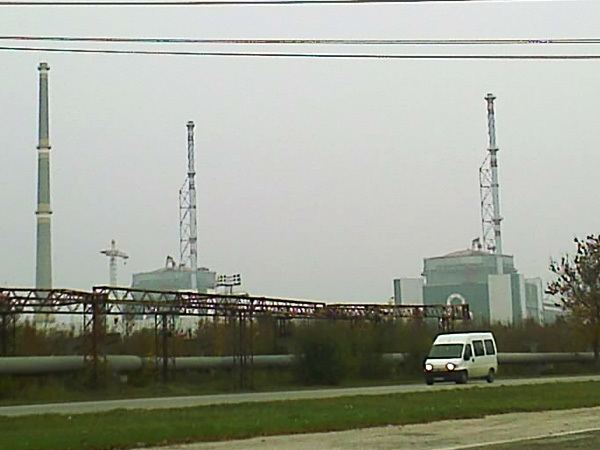Status Operational Phone +359 97 372 100 | Opened 28 October 1974 Construction began 1970 | |
 | ||
Commission date 28 October 1974 (28 October 1974)1974 (Unit 1)1975 (Unit 2)1980 (Unit 3)1982 (Unit 4)1987 (Unit 5)1991 (Unit 6) Decommission date 2004 (Units 1 & 2)2007 (Units 3 & 4) Similar | ||
Ku ku kozloduy nuclear power plant joke
The Kozloduy Nuclear Power Plant is a nuclear power plant in Bulgaria situated 120 kilometres (75 mi) north of Sofia and 5 kilometres (3.1 mi) east of Kozloduy, a town on the Danube river, near the border with Romania. It is the country's only nuclear power plant and the largest in the region. The construction of the first reactor began on 6 April 1970.
Contents
- Ku ku kozloduy nuclear power plant joke
- Antonyia parvanova on kozloduy nuclear power plant
- Safety concerns and consequent shutdown of Units 1 to 4
- Pressure to restart
- Ownership
- Future expansion
- References
Kozloduy NPP currently manages 2 pressurized water reactors with a total output of 2000 MWe. Units 5 and 6, constructed in 1987 and 1991 respectively, are VVER-1000 reactors. By 2017 Unit 5 will be upgraded to reach a capacity of 1,100 MWe, as part of a programme to extend the life of the unit by 30 years. A seventh 1,000 MW unit will be installed, using an assembled reactor from the terminated Belene NPP project.
The older and smaller Units 1 to 4 were all shut down by 2007.
Antonyia parvanova on kozloduy nuclear power plant
Safety concerns and consequent shutdown of Units 1 to 4
Kozloduy NPP previously operated four older reactors of the VVER-440/230 design, but under a 1993 agreement between the European Commission and the Bulgarian government, Units 1 and 2 were taken off-line at the beginning of 2004. An unpublished 1995 report by the United States Department of Energy had supposedly listed those units among the world's "ten most dangerous reactors". On 21 October 2010, licenses for the shutdown reactors were transferred to Bulgaria state radioactive waste enterprise DP RAO, signaling the formal beginning of decommissioning work.
Throughout the 1990s and early 2000s Units 3 and 4, originally licensed for operation until 2011 and 2013, respectively, underwent substantial safety improvements and, after rigorous inspections, received positive reviews from the IAEA in 2002, and from the World Association of Nuclear Operators (WANO) in the following year, concluding that "no technical reasons exist for the early closure of units 3 & 4". Backed by these findings, the government had hoped to convince the European Commission to allow a postponement of the agreed pre-accession shutdown; from a legal and political standpoint, however, this proved untenable. Units 3 and 4 were taken out of operation in the final hours of 2006, immediately prior to the country's accession to the European Union.
82 metric tons of its spent fuel were sent to a repository in Zheleznogorsk, Krasnoyarsk Krai during 2001 and 2002. In 2008, officials at the power plant announced their intention to use CONSTOR storage casks for this purpose.
Prior to the shutdown of units 3 and 4, Kozloduy NPP produced 44% of Bulgaria's electricity supply; as of March 2006, Bulgaria exported about 14% of its electricity production.
Pressure to restart
In January 2009 Bulgaria's president suggested that Unit 3 be restarted in light of the gas dispute between Russia and Ukraine and resulting power shortages in the region. Under the conditions of its Accession Treaty Bulgaria may request temporary derogation from its commitments in the event of serious economic difficulties arising within the first three years of membership in the union.
Ownership
Kozloduy Nuclear Power Plant is a subsidiary of Bulgarian Energy Holding EAD.
Future expansion
Bulgaria's government recently decided to start the construction of a new reactor in Kozloduy after it gave up on the construction of what was supposed to be the country's second nuclear power plant in Belene. Thus, the Bulgarian government decided to install in Kozloduy the 1000 MW reactor that the Russian state company Atomstroyexport already produced for the Belene NPP. The Belene Nuclear Power Plant project was terminated in late March 2012.
In October 2013, the Ministry of Environment and Water approved the environmental impact assessment report on the investment proposal for Unit 7, thereby giving a green light for its construction. A month later it was announced that construction of the reactor could begin in 2019 if full approval is granted by the Council of Ministers in 2014. The Bulgarian Energy Holding (short BEH) propose to construct a Westinghouse AP1000. Negotiations between the BEH and Westinghouse already started.
In 2013 the Austrian Environment Agency prepared a report on the Bulgarian Ministry for the Environment's Environmental Impact Assessment (EIA) on the proposed 7th unit of the Kozloduy Nuclear Power Plant. It assesses whether the EIA-Report allows for making reliable conclusions about the potential trans-boundary impacts on Austria. The Austrian report considers the assumption, that the Kozloduy NPP site is flood-proof, to be well-founded and the seismic hazard at the site to be low (but points out that the seismic hazard study needs updating as it was performed 20 years ago). It also highlights a number of unsubstantiated claims and some failings in the Bulgarian EIA report. These include:
